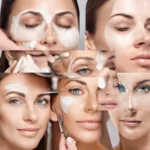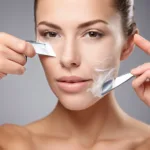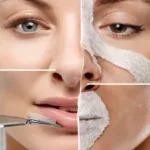29 December 2023
The Gentle Approach: Discovering Effective and Natural Solutions for Removing Facial Hair Without Dermaplaning
Are you tired of dealing with unwanted facial hair but hesitant to try dermaplaning? Well, you’re not alone. Dermaplaning, a popular exfoliation technique that involves using a sharp blade to remove peach fuzz and dead skin cells from the face, has gained significant popularity in recent years. However, if the idea of scraping a blade against your skin makes you cringe, fear not! There are natural alternatives to dermaplaning that can effectively remove facial hair without the need for sharp objects or expensive salon visits.
In this article, we will explore some of the best natural alternatives to dermaplaning for facial hair removal. From ancient remedies to modern techniques, we will delve into the world of natural ingredients and methods that can help you achieve smooth, hair-free skin. Whether you have sensitive skin, are looking for a more budget-friendly option, or simply prefer a gentler approach, we’ve got you covered. So, say goodbye to those pesky facial hairs and hello to a more natural and sustainable way of achieving a flawless complexion.
Key Takeaways for :
1. Natural alternatives to dermaplaning, such as sugaring and threading, offer effective and less invasive options for facial hair removal.
2. Sugaring, a technique that uses a mixture of sugar, lemon juice, and water, is a gentle and natural way to remove facial hair without causing irritation or redness.
3. Threading, a method that involves using a twisted thread to remove hair from the root, is another natural alternative that provides precise hair removal and can be done at home or by a professional.
4. Regular exfoliation with natural ingredients like sugar scrubs or oatmeal can help reduce the appearance of facial hair and prevent ingrown hairs.
5. Natural remedies like turmeric paste or papaya can also be used to slow down the growth of facial hair and lighten its color, providing a longer-lasting solution for facial hair removal.
By exploring these natural alternatives to dermaplaning, individuals can find suitable methods that align with their preferences and skin sensitivities, offering effective and gentle ways to remove facial hair without resorting to more invasive techniques.
Controversial Aspect 1: Effectiveness of Natural Alternatives
One of the controversial aspects surrounding natural alternatives to dermaplaning for facial hair removal is the effectiveness of these methods. While some proponents claim that natural remedies such as sugar waxing, turmeric paste, or homemade scrubs can effectively remove facial hair, others argue that the results are not as satisfactory as professional treatments like dermaplaning.
Supporters of natural alternatives argue that these methods have been used for centuries and can be just as effective as dermaplaning. For example, sugar waxing is believed to remove hair from the root, resulting in slower regrowth compared to shaving. Turmeric paste is said to have anti-inflammatory properties and can reduce the appearance of facial hair over time. Homemade scrubs, on the other hand, are claimed to exfoliate the skin and remove dead cells along with the hair.
However, skeptics argue that the effectiveness of these natural alternatives can vary greatly depending on individual hair type and thickness. They assert that while some people may see noticeable results, others may experience minimal to no effect. Additionally, the results achieved with natural remedies may not be as long-lasting or precise as dermaplaning, which uses a surgical blade to remove hair and exfoliate the skin.
It is important to note that scientific research on the effectiveness of natural alternatives for facial hair removal is limited. Most of the evidence supporting these methods comes from anecdotal experiences rather than rigorous scientific studies. Therefore, it is difficult to draw definitive conclusions about the true effectiveness of natural alternatives compared to dermaplaning.
Controversial Aspect 2: Safety and Potential Side Effects
Another controversial aspect of natural alternatives to dermaplaning is the safety and potential side effects associated with these methods. While dermaplaning is performed by trained professionals in controlled environments, natural remedies are often self-administered at home, which raises concerns about potential risks.
Advocates of natural alternatives argue that these methods are generally safe when used correctly and in moderation. For example, sugar waxing is considered a gentler alternative to traditional waxing because it does not require the use of harsh chemicals. Turmeric paste, often mixed with other ingredients like milk or yogurt, is believed to be safe for most skin types. Homemade scrubs, typically made from natural ingredients like sugar or coffee grounds, are considered less abrasive than commercial exfoliants.
However, critics point out that improper use of natural remedies can lead to adverse effects. For instance, if sugar waxing is not done correctly, it can cause skin irritation, burns, or even infections. Turmeric paste may stain the skin or cause allergic reactions in some individuals. Homemade scrubs, if too abrasive, can damage the skin’s protective barrier and lead to redness or sensitivity.
It is essential for individuals considering natural alternatives to dermaplaning to be aware of their skin type, allergies, and any pre-existing conditions that may affect the safety and suitability of these methods. Patch testing and consulting with a dermatologist or esthetician can help minimize the risk of adverse reactions.
Controversial Aspect 3: Long-Term Impact on Hair Growth
The long-term impact of natural alternatives on hair growth is another controversial aspect that divides opinions. Some proponents argue that regular use of natural remedies can lead to reduced hair growth over time, resulting in finer, sparser facial hair. They believe that these methods disrupt the hair follicles and inhibit regrowth.
Supporters of natural alternatives often cite traditional practices like sugaring, which has been used for centuries in various cultures, as evidence of its long-term hair reduction effects. They claim that continuous hair removal through natural methods weakens the hair follicles, leading to diminished regrowth.
However, skeptics argue that there is no scientific evidence to support the claim that natural alternatives can permanently reduce hair growth. They maintain that these methods only provide temporary hair removal and that any perceived long-term effects are likely due to individual variations in hair growth cycles.
It is important to approach claims of long-term hair reduction with caution and skepticism. While natural alternatives may offer temporary hair removal benefits, they are unlikely to provide permanent or significant reduction in hair growth without professional interventions such as laser or electrolysis treatments.
Natural alternatives to dermaplaning for facial hair removal present several controversial aspects. the effectiveness of these methods is debated, with proponents highlighting their historical use and anecdotal evidence, while skeptics question their reliability compared to professional treatments. safety and potential side effects are also a concern, as improper use of natural remedies can lead to adverse reactions. lastly, the long-term impact on hair growth remains uncertain, with conflicting claims about the ability of natural alternatives to permanently reduce hair regrowth. as with any beauty treatment, it is essential to consider individual factors, consult professionals, and make informed decisions.
1. The Rise of Natural Alternatives
With the increasing popularity of natural and organic skincare products, many individuals are seeking natural alternatives to dermaplaning for facial hair removal. This section will explore the reasons behind this trend and discuss the benefits of opting for natural methods.
2. Turmeric: Nature’s Secret for Hair Removal
Turmeric, a bright yellow spice commonly found in Indian cuisine, has gained recognition for its numerous health and beauty benefits. This section will delve into the science behind turmeric’s hair removal properties, highlight the different ways it can be used for facial hair removal, and provide tips for incorporating it into a skincare routine.
3. The Power of Papaya: Enzymatic Hair Removal
Papaya contains an enzyme called papain, which has been found to effectively break down hair follicles, leading to smoother skin. In this section, we will explore the benefits of using papaya for facial hair removal, discuss different methods of application, and provide insights from individuals who have experienced success with this natural alternative.
4. Sugaring: A Sweet Solution
Sugaring is an ancient hair removal technique that involves using a sticky paste made from sugar, lemon juice, and water. This section will explain the process of sugaring, compare it to other hair removal methods, and provide step-by-step instructions for those interested in trying it at home.
5. The Magic of Chickpea Flour
Chickpea flour, also known as gram flour or besan, has been used for centuries in traditional Indian skincare routines. This section will explore the hair removal properties of chickpea flour, discuss different recipes and methods for facial hair removal, and provide tips for optimal results.
6. The Gentle Touch of Oatmeal
Oatmeal is not only a beloved breakfast food but also a gentle exfoliant with hair removal benefits. This section will delve into the science behind oatmeal’s hair removal properties, discuss different ways to incorporate it into a skincare routine, and provide recommendations for individuals with sensitive skin.
7. Natural Hair Inhibitors: Slowing Down Regrowth
While natural alternatives can effectively remove facial hair, some individuals may also be interested in slowing down the regrowth process. This section will explore natural hair inhibitors such as spearmint tea, lavender oil, and saw palmetto, discussing their effectiveness and providing insights from individuals who have incorporated them into their hair removal routines.
8. DIY vs. Professional: Making the Right Choice
When it comes to facial hair removal, individuals have the option to either try natural methods at home or seek professional assistance. This section will compare the pros and cons of DIY natural hair removal versus professional treatments, helping readers make an informed decision based on their preferences, budget, and desired results.
9. Case Studies: Real Stories of Success
To provide a firsthand perspective, this section will feature case studies of individuals who have successfully incorporated natural alternatives to dermaplaning for facial hair removal into their skincare routines. These stories will highlight the challenges faced, the methods used, and the results achieved, offering inspiration and guidance to readers.
10. Embracing Natural Beauty: Beyond Hair Removal
This final section will emphasize the importance of embracing natural beauty and self-acceptance beyond hair removal. It will explore the societal pressures surrounding facial hair and encourage readers to embrace their unique features, fostering self-confidence and self-love.
1. to Dermaplaning
Dermaplaning is a popular method for facial hair removal that involves using a sharp blade to exfoliate the skin and remove fine vellus hairs, also known as peach fuzz. Although it provides immediate results and leaves the skin feeling smooth, dermaplaning can be expensive and may not be suitable for everyone. For those who prefer natural alternatives, there are several methods that can be used to achieve similar results without the use of a blade.
2. Exfoliation with Natural Ingredients
One natural alternative to dermaplaning is exfoliating the skin using ingredients commonly found in the kitchen. Sugar and salt are excellent choices for creating homemade exfoliating scrubs. These granules help remove dead skin cells and promote cell turnover, resulting in a smoother complexion. Additionally, ingredients like honey and yogurt can be added to these scrubs to provide hydration and nourishment to the skin.
2.1 Sugar Scrub
To create a sugar scrub, simply mix equal parts of granulated sugar and a carrier oil, such as coconut or olive oil. Gently massage the scrub onto damp skin in circular motions, focusing on areas with facial hair. Rinse thoroughly with warm water and pat dry. The sugar granules will help slough off dead skin cells and the oil will moisturize the skin, leaving it soft and smooth.
2.2 Salt Scrub
Similar to the sugar scrub, a salt scrub can be made by combining equal parts of salt and a carrier oil. However, it is important to use a finer grain salt, such as sea salt or Himalayan salt, to avoid excessive abrasion. Apply the scrub to damp skin and gently massage in circular motions. Rinse well and pat dry. The salt will effectively exfoliate the skin, while the oil will provide nourishment and hydration.
3. Facial Hair Removal with Natural Ingredients
In addition to exfoliation, there are natural ingredients that can help weaken and remove facial hair over time. These alternatives are milder than dermaplaning but can still provide noticeable results with regular use.
3.1 Turmeric Paste
Turmeric is a popular spice known for its anti-inflammatory and anti-hair growth properties. To create a turmeric paste, mix one tablespoon of turmeric powder with one tablespoon of milk or yogurt to form a thick paste. Apply the paste to the areas with facial hair and leave it on for 15-20 minutes. Rinse off with warm water and repeat 2-3 times a week. Over time, the turmeric will help weaken the hair follicles, making the hair finer and less noticeable.
3.2 Papaya and Turmeric Mask
Papaya contains an enzyme called papain, which can help break down hair follicles and inhibit hair growth. To create a papaya and turmeric mask, blend half a ripe papaya with one teaspoon of turmeric powder until smooth. Apply the mask to the face and leave it on for 15-20 minutes. Rinse off with warm water and repeat 2-3 times a week. The combination of papaya and turmeric will not only help reduce facial hair but also provide additional benefits for the skin, such as brightening and exfoliation.
3.3 Chickpea Flour and Yogurt Mask
Chickpea flour, also known as gram flour, has been used for centuries in traditional beauty remedies for its hair removal properties. Combine two tablespoons of chickpea flour with enough yogurt to form a paste. Apply the mask to the face and let it dry for 15-20 minutes. Once dry, gently rub the mask off in circular motions. Rinse with warm water and repeat 2-3 times a week. The chickpea flour will help weaken the hair follicles, while the yogurt will nourish and soothe the skin.
While dermaplaning may be an effective method for facial hair removal, natural alternatives can provide similar results without the need for a blade. Exfoliating with homemade scrubs and using ingredients like turmeric, papaya, and chickpea flour can help weaken and remove facial hair over time. These natural alternatives offer a gentler approach to facial hair removal and can be easily incorporated into a skincare routine.
FAQs:
1. What is dermaplaning and why are people looking for natural alternatives?
Dermaplaning is a cosmetic procedure that involves using a sharp blade to exfoliate the top layer of skin and remove facial hair. While it can provide smooth and radiant skin, some people prefer natural alternatives due to concerns about potential side effects, cost, or simply wanting to use more natural methods.
2. What are some natural alternatives to dermaplaning for facial hair removal?
There are several natural alternatives to dermaplaning for facial hair removal, including:
- Threading: This ancient hair removal technique uses a twisted thread to remove facial hair from the root.
- Sugaring: A paste made of sugar, lemon juice, and water is applied to the skin and then removed, taking the hair with it.
- Waxing: A warm wax is applied to the skin and then pulled off, removing the hair from the root.
- Tweezing: Using a pair of tweezers to pluck individual hairs from the root.
- Depilatory creams: These creams dissolve the hair at the skin’s surface, making it easy to wipe away.
3. Are natural alternatives as effective as dermaplaning?
The effectiveness of natural alternatives to dermaplaning can vary depending on individual factors such as hair thickness and skin sensitivity. While dermaplaning provides immediate results, some natural methods may require more time and multiple sessions to achieve similar outcomes.
4. Are there any risks or side effects associated with natural alternatives?
While natural alternatives generally have fewer risks compared to dermaplaning, it’s important to be aware of potential side effects. These can include skin irritation, redness, or ingrown hairs. It’s advisable to do a patch test and follow the instructions carefully to minimize any adverse reactions.
5. Can natural alternatives be used on all skin types?
Most natural alternatives can be used on all skin types, but it’s important to consider individual sensitivities and allergies. Some methods, such as sugaring or waxing, may not be suitable for those with extremely sensitive or reactive skin. Consulting a dermatologist or esthetician can provide personalized advice based on your specific skin type.
6. Are natural alternatives more cost-effective than dermaplaning?
Generally, natural alternatives tend to be more cost-effective than dermaplaning. While dermaplaning can be quite expensive, natural methods can often be done at home or at a salon for a fraction of the cost. However, it’s important to consider the long-term costs, including the need for regular maintenance and potential professional assistance.
7. How long do the results of natural alternatives last?
The duration of results from natural alternatives can vary depending on the method used and individual hair growth rates. Threading, waxing, and sugaring can provide results that last up to four weeks, while depilatory creams may last around a week. Regular maintenance is usually required to keep the desired results.
8. Can natural alternatives cause skin discoloration?
When done correctly, natural alternatives should not cause skin discoloration. However, improper technique or using products that are too harsh for your skin type can potentially lead to temporary or permanent skin discoloration. It’s important to follow instructions carefully and seek professional advice if you have any concerns.
9. Can natural alternatives be used on other parts of the body?
Yes, natural alternatives can be used on other parts of the body, such as the arms, legs, or bikini area. However, it’s important to consider the sensitivity of the skin in those areas and adjust the method accordingly. For example, facial hair may be more delicate than body hair, so caution should be exercised when using certain techniques.
10. Are there any precautions to take before using natural alternatives?
Before using natural alternatives, it’s important to ensure that your skin is clean and dry. Avoid applying any creams, lotions, or oils prior to the hair removal process, as they can interfere with the effectiveness of the method. Additionally, if you have any skin conditions or are taking medications that may affect your skin’s sensitivity, it’s advisable to consult a healthcare professional before proceeding.
Concept 1: Dermaplaning
Dermaplaning is a cosmetic procedure that involves using a sharp blade to remove facial hair and exfoliate the skin. It is typically done in a salon or spa by a trained professional. The blade is gently scraped across the skin, removing the hair and the top layer of dead skin cells, leaving the skin smooth and radiant.
Concept 2: Exfoliation
Exfoliation is the process of removing dead skin cells from the surface of the skin. This helps to improve the texture and appearance of the skin, making it look brighter and more youthful. There are different methods of exfoliation, including physical exfoliation (using scrubs or brushes) and chemical exfoliation (using acids or enzymes).
Concept 3: Natural Alternatives
Natural alternatives to dermaplaning for facial hair removal are methods that use natural ingredients or tools to achieve similar results without the need for a sharp blade. These alternatives are often gentler on the skin and can be done at home, making them more accessible and affordable.
Alternative 1: Facial Hair Removal with Sugar Wax
Sugar waxing is a natural method of hair removal that has been used for centuries. It involves making a sticky paste with sugar, lemon juice, and water, which is applied to the skin in the opposite direction of hair growth. The paste is then quickly pulled off, removing the hair from the root.
Sugar waxing is effective for facial hair removal because the sticky paste adheres to the hair and pulls it out from the root. It also exfoliates the skin, removing dead skin cells and leaving the skin smooth and soft. This method can be done at home with simple ingredients and is suitable for all skin types.
Alternative 2: Facial Hair Removal with Turmeric Paste
Turmeric paste is another natural alternative for facial hair removal. Turmeric has been used for centuries in traditional medicine for its anti-inflammatory and skin-brightening properties. When mixed with other ingredients like chickpea flour and milk, it forms a paste that can be applied to the skin to remove facial hair.
The active compound in turmeric, called curcumin, inhibits hair growth and helps to lighten the hair over time. The paste also acts as a gentle exfoliant, removing dead skin cells and revealing smoother skin. This method is suitable for all skin types, but it may temporarily stain the skin yellow, so it’s important to wash it off thoroughly.
Alternative 3: Facial Hair Removal with Dermaplaning Tools
If you prefer a physical method of hair removal but want to avoid using a sharp blade, dermaplaning tools can be a good alternative. These tools are designed to mimic the effects of dermaplaning without the risk of cuts or nicks. They usually have a small blade or razor edge that gently scrapes off the hair and dead skin cells.
Dermaplaning tools are easy to use at home and can be used on various parts of the face, including the upper lip, chin, and cheeks. They provide instant results, leaving the skin smooth and hair-free. However, it’s important to follow the instructions carefully to avoid irritation or injury.
Dermaplaning is a popular method for facial hair removal and exfoliation, but there are natural alternatives available for those who prefer a gentler approach. sugar waxing, turmeric paste, and dermaplaning tools are effective methods that can be done at home with simple ingredients or tools. these alternatives provide similar results without the need for a sharp blade, making them accessible and safe for all skin types.
In conclusion, natural alternatives to dermaplaning for facial hair removal offer effective and safe options for those looking to remove unwanted hair without resorting to harsh methods. The key points discussed in this article highlight the various natural alternatives available, including sugaring, threading, and home remedies such as turmeric and papaya. These alternatives not only provide a gentler approach to hair removal but also offer additional benefits for the skin, such as exfoliation and nourishment.
Sugaring, a method that uses a paste made of sugar, water, and lemon juice, is an excellent alternative to dermaplaning. It effectively removes hair from the root and slows down regrowth over time. Threading, on the other hand, involves using a twisted thread to remove hair from the follicle, providing precise and long-lasting results. Additionally, home remedies like turmeric and papaya offer natural and cost-effective options for facial hair removal. Turmeric has anti-inflammatory properties and can help reduce hair growth, while papaya contains enzymes that break down hair follicles, making them easier to remove.
By exploring these natural alternatives, individuals can find methods that suit their preferences and needs, while avoiding the potential risks and side effects associated with dermaplaning. It is important to remember that everyone’s skin is unique, and what works for one person may not work for another. It is advisable to test these alternatives on a small patch of skin before applying them to the entire face. With the right approach and consistent use, natural alternatives can provide effective and gentle facial hair removal solutions.



